List of Renaissance Mathematicians
The people below were born in 1375 or later.
Chinese, Indian, and Arabic
mathematicians are in another file.
0. Brunelleschi
Encyclopaedia Britannica
or
Academic Edition,
requires campus password)
MACTUTOR.
Filippo Brunelleschi
Born: 1377 in Florence, Italy
Died: 15 April 1446 in Florence, Italy
BRITANNICA.
Filippo Brunelleschi
Born: 1377, Florence [Italy]
Died: April 15, 1446, Florence
also called
Summary:
Architect and engineer who was one of the pioneers of early Renaissance architecture in Italy.
His major work is the dome of the Florence Cathedral (1420–36), constructed with the aid of machines that Brunelleschi invented expressly for the project.
WIKI.
Filippo Brunelleschi (1377 – April 15, 1446)
Summary:
A great Florentine architect of the Italian Renaissance.





1. Nicholas Of Cusa
Biography in Dictionary of Scientific Biography
Encyclopaedia Britannica
(also:
Academic Edition,
requires campus password)
MACTUTOR.
Nicholas of Cusa
Born: 1401 in Kues, Trier (now Germany)
Died: 11 Aug 1464 in Todi, Papal States (now Italy)
Summary:
German philosopher, bishop. Interested in geometry and logic
as well as in philosophy and astronomy.
BRITANNICA.
Nicholas Of Cusa
Born: 1401, Kues, Trier
Died: Aug. 11, 1464, Todi, Papal States
Also: German Nikolaus Von Cusa, Latin Nicolaus Cusanus
Summary:
A cardinal, mathematician, scholar, experimental scientist, influential philosopher.
Stressed the incomplete nature of man's knowledge of God and of the universe.
WIKI.
Nicholas of Cusa (1401– August 11, 1464)
Also: Nicolaus Cusanus and Nicholas of Kues
Summary:
German cardinal of the Catholic Church, a philosopher, jurist,
mathematician, astronomer.
Widely considered as one of the greatest geniuses and polymaths of the 15th century.


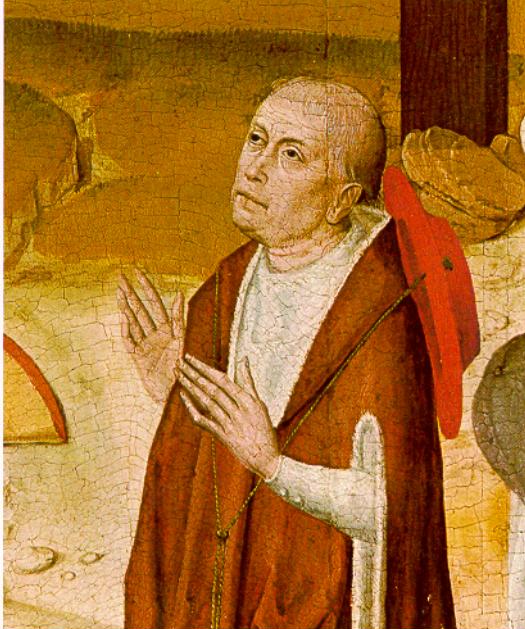
2. Alberti
Biography in Dictionary of Scientific Biography
Encyclopaedia Britannica
(also:
Academic Edition,
requires campus password)
MACTUTOR.
Leone Battista Alberti
Born: 18 Feb 1404 in Genoa, Italy
Died: 3 April 1472 in Rome, Italy
Summary: Wrote the first general treatise on the laws of perspective.
Also wrote a book on cryptography containing the first example of a frequency table.
BRITANNICA.
Leon Battista Alberti
Born: Feb. 14, 1404, Genoa
Died: April 25, 1472, Rome
Summary:
Italian Humanist, architect, principal initiator of Renaissance art theory.
In personality, works, and breadth of learning, the prototype of the Renaissance “universal man.”
WIKI.
Leone Battista Alberti (February 14, 1404 – April 25, 1472)
In Italy, his first name is usually spelled Leon.
Summary:
Italian painter, poet, linguist, philosopher, cryptographer, musician, architect, general Renaissance polymath.
His life was described in Giorgio Vasari's Vite.
(Alberti was an illustrious Florentine family, rivals of the Medicis and the Albizzi).

 Bigger image of statue
Bigger image of statue
 Santa Maria Novella, in Florence, Italy.
Bigger image.
Santa Maria Novella, in Florence, Italy.
Bigger image.
3. Piero della Francesca
Biography in Dictionary of Scientific Biography
Encyclopaedia Britannica
(also:
Academic Edition,
requires campus password)
MACTUTOR.
Piero della Francesca
Born: 1412 in Borgo San Sepolero (now Sansepolcro), Italy
Died: 12 Oct 1492 in Borgo San Sepolero, Italy
Summary:
An Italian artist who pioneered the use of perspective in Renaissance art.
He went on to write several mathematical treatises.
BRITANNICA.
Piero Della Francesca
Born: c. 1420, Sansepolcro?, Republic of Florence
Died: October 12, 1492, Sansepolcro
Summary:
Painter. His serene, disciplined exploration of perspective had little influence on his contemporaries but came to be recognized in the 20th century as a major contribution to the Italian Renaissance.
The fresco cycle “The Legend of the True Cross” (1452–66) and the diptych portrait of Federico da Montefeltro, duke of Urbino, and his consort (1465) are among his best known works.
WIKI.
Piero della Francesca (born probably in Borgo Santo Sepolcro, Tuscany, c. 1420,
there October 12, 1492)
Summary:
Italian artist of the Early Renaissance.
To contemporaries, known as a mathematician and geometer as well as an artist.
Now chiefly appreciated for his art.
His painting was characterized by its serene humanism and its use of geometric forms, particularly in relation to perspective and foreshortening.
 Portrait from Vasari's Lives (1550)
Portrait from Vasari's Lives (1550)
 A sample of the art of Piero della Francesca (c. 1472)
A sample of the art of Piero della Francesca (c. 1472)
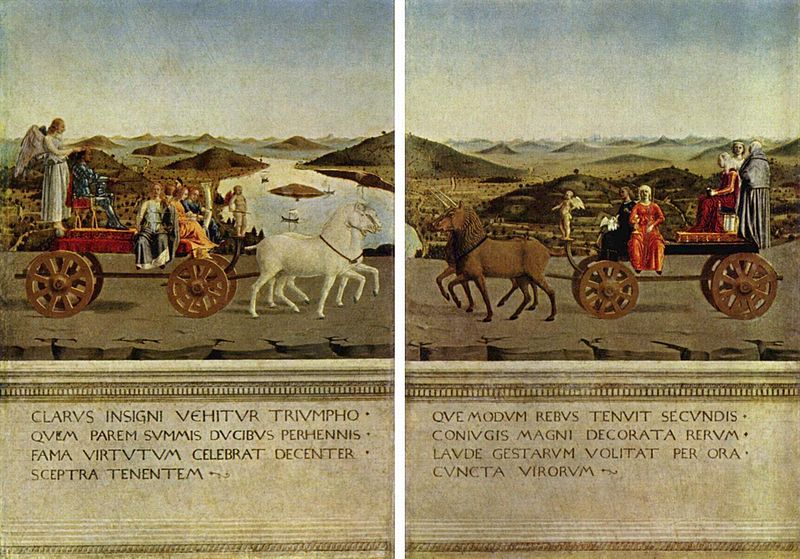 A sample of the art of Piero della Francesca (1472)
A sample of the art of Piero della Francesca (1472)
 A sample of the art of Piero della Francesca (1472)
A sample of the art of Piero della Francesca (1472)
4. Peurbach
Biography in Dictionary of Scientific Biography
MACTUTOR.
Georg Peurbach
Born: 30 May 1423 in Peuerbach, Austria
Died: 8 April 1461 in Vienna, Austria
Summary:
Austrian astronomer.
Published observations as well as a textbook on trigonometric calculation.
WIKI.
Georg Purbach (born May 30, 1423 in Purbach near Linz – April 8, 1461 in Vienna)
Also known as Georg von Peuerbach, Peurbach, Purbach, Purbachius, his real surname is unknown
Summary:
Austrian astronomer and mathematician.
Credited with the invention of several scientific instruments, including the regula, the geometrical square, the "Jacob's Staff." The Purbach crater on the Moon is named after him.
5. Piero Borgi
Biography in Dictionary of Scientific Biography
MACTUTOR.
Piero Borgi
Born: about 1424 in Venice, Italy
Died: about 1484
Short Entry: Author of the best known 15th Century Italian arithmetic books,
including a highly successful commercial arithmetic book which ran to at least seventeen editions.
His books include
Addiones in quibus etiam sunt replicae Mathei Boringii (1483)
Arithmetica (1484)
Libro de Abacho de arithmetica
De arte mathematiche
6. Regiomontanus
Biography in Dictionary of Scientific Biography
Encyclopaedia Britannica
(also:
Academic Edition,
requires campus password)
Crater Regiomontanus
MACTUTOR.
Johann Müller Regiomontanus
Born: 6 June 1436 in Unfinden (near Königsberg), Lower Franconia (now in Bayern, Germany)
Died: 6 July 1476 in Rome, Italy
Summary:
Regiomontanus or Johann Müller.
German scholar.
Made important contributions to trigonometry and astronomy.
BRITANNICA.
Regiomontanus
Born: June 6, 1436, Königsberg, archbishopric of Mainz [Germany]
Died: July 6, 1476, Rome, Papal States [Italy]
Regiomontanus was the Latin name of Johannes Müller von Königsberg
Summary:
Foremost mathematician and astronomer of 15th-century Europe,
a sought-after astrologer, and one of the first printers.
WIKI.
Johannes Müller von Königsberg (June 6, 1436 – July 6, 1476)
Known by his Latin pseudonym Regiomontanus
Summary:
An important German mathematician, astronomer and astrologer.
Full Latin name: Joannes de Regio monte. Abbreviated to Regiomontanus (from the Latin for "Königsberg"—"King's Mountain").



Big version
7. Nicolas Chuquet
Biography in Dictionary of Scientific Biography
Paris street: Rue Nicolas Chuquet (17th Arrondissement)
MACTUTOR.
NAME
Born: 1445 in Paris, France
Died: 1488 in Lyon, France
Summary:
Nicolas Chuquet was a French mathematician who wrote the earliest French algebra book.
WIKI.
Nicolas Chuquet (born 1445 (some sources say c. 1455) in Paris, France; died 1488 (some sources say c. 1500) in Lyon, France)
Summary:
French mathematician.
His great work, Triparty en la science des nombres, unpublished in his lifetime.
Most of it, however, was copied without attribution by Estienne de La Roche in his 1520 textbook, Larismetique.
In the 1870s, scholar A Aristide Marre discovered Chuquet's manuscript and published it in 1880.
The manuscript contained notes in de la Roche's handwriting.
Chuquet's thinking was brilliant and far ahead of its time.
He invented his own notation for algebraic concepts and exponentiation.
May have been the first mathematician to recognize zero and negative numbers as exponents.
8. Pacioli
Biography in Dictionary of Scientific Biography
MACTUTOR.
Luca Pacioli
Born: 1445 in Sansepolcro, Italy
Died: 1517 in Sansepolcro, Italy
Summary:
Italian mathematician.
Published the influential book
Suma in 1494 giving a summary of all the mathematics known at that time.
WIKI.
Luca Pacioli
Fra Luca Bartolomeo de Pacioli (sometimes Paciolo) (1445–1514 or 1517)
He was also called Luca di Borgo after his birthplace, Borgo Santo Sepolcro, Tuscany.
Summary:
Italian mathematician and Franciscan friar.
Collaborator with Leonardo da Vinci.
Seminal contributor to the field now known as accounting.


 The painting Ritratto di Frà Luca Pacioli (1495) now in Naples.
Painter unknown (perhaps Jacopo de' Barbari).
In the painting Pacioli is demonstrating a theorem by Euclid.
Table with
geomerical tools: slate, chalk, compass, a dodecahedron.
A rhombicuboctahedron half-filed with water is hanging to his right.
The painting Ritratto di Frà Luca Pacioli (1495) now in Naples.
Painter unknown (perhaps Jacopo de' Barbari).
In the painting Pacioli is demonstrating a theorem by Euclid.
Table with
geomerical tools: slate, chalk, compass, a dodecahedron.
A rhombicuboctahedron half-filed with water is hanging to his right.
 Woodcut
by Leonardo da Vinci for the Divina Proportione by Luca Pacioli 1509.
A rhombicuboctahedron,
an
Archimedean solid. F=26, E=48, V=24.
Woodcut
by Leonardo da Vinci for the Divina Proportione by Luca Pacioli 1509.
A rhombicuboctahedron,
an
Archimedean solid. F=26, E=48, V=24.
 Woodcut
from the Divina Proportione by Luca Pacioli 1509.
The divine proportion applied to the human face.
Woodcut
from the Divina Proportione by Luca Pacioli 1509.
The divine proportion applied to the human face.
9. Leonardo da Vinci
Biography in Dictionary of Scientific Biography
Encyclopaedia Britannica
(also:
Academic Edition,
requires campus password)
Crater da Vinci
Crater da Vinci on Mars
Paris street name: Rue Leonardo da Vinci (16th Arrondissement)
MACTUTOR.
Leonardo da Vinci
Born: 15 April 1452 in Vinci (near Empolia), Italy
Died: 2 May 1519 in Cloux, Amboise, France
Summary:
Italian artist and scholar who had many talents in addition to his painting.
Worked on mechanics, though geometry was his main love.
Involved in hydrodynamics, anatomy, mechanics, mathematics and optics.
BRITANNICA.
Leonardo da Vinci
Born: April 15, 1452, Anchiano, near Vinci, Republic of Florence [now in Italy]
Died: May 2, 1519, Cloux [now Clos-Lucé], France
also
Summary:
Italian painter, draftsman, sculptor, architect, and engineer whose genius, perhaps more than that of any other figure, epitomized the Renaissance humanist ideal.
His Last Supper (1495–98) and Mona Lisa (c. 1503–06) are among the most widely popular and influential paintings of the Renaissance.
His notebooks reveal a spirit of scientific inquiry and a mechanical inventiveness that were centuries ahead of their time.
WIKI.
Leonardo da Vinci
Leonardo di ser Piero da Vinci (April 15, 1452 – May 2, 1519)
Summary:
Italian polymath: architect, anatomist, sculptor, engineer, inventor, mathematician,
musician, and painter.
The archetype of the "Renaissance man", a man infinitely curious and equally inventive.
Widely considered to be one of the greatest painters of all time and a universal genius.
 Statue outside the Uffizi, Florence
Statue outside the Uffizi, Florence

 The first of these is thought to be a self portrait.
The first of these is thought to be a self portrait.
 Leonardo da Vinci's Vitruvian Man.
Leonardo da Vinci's Vitruvian Man.
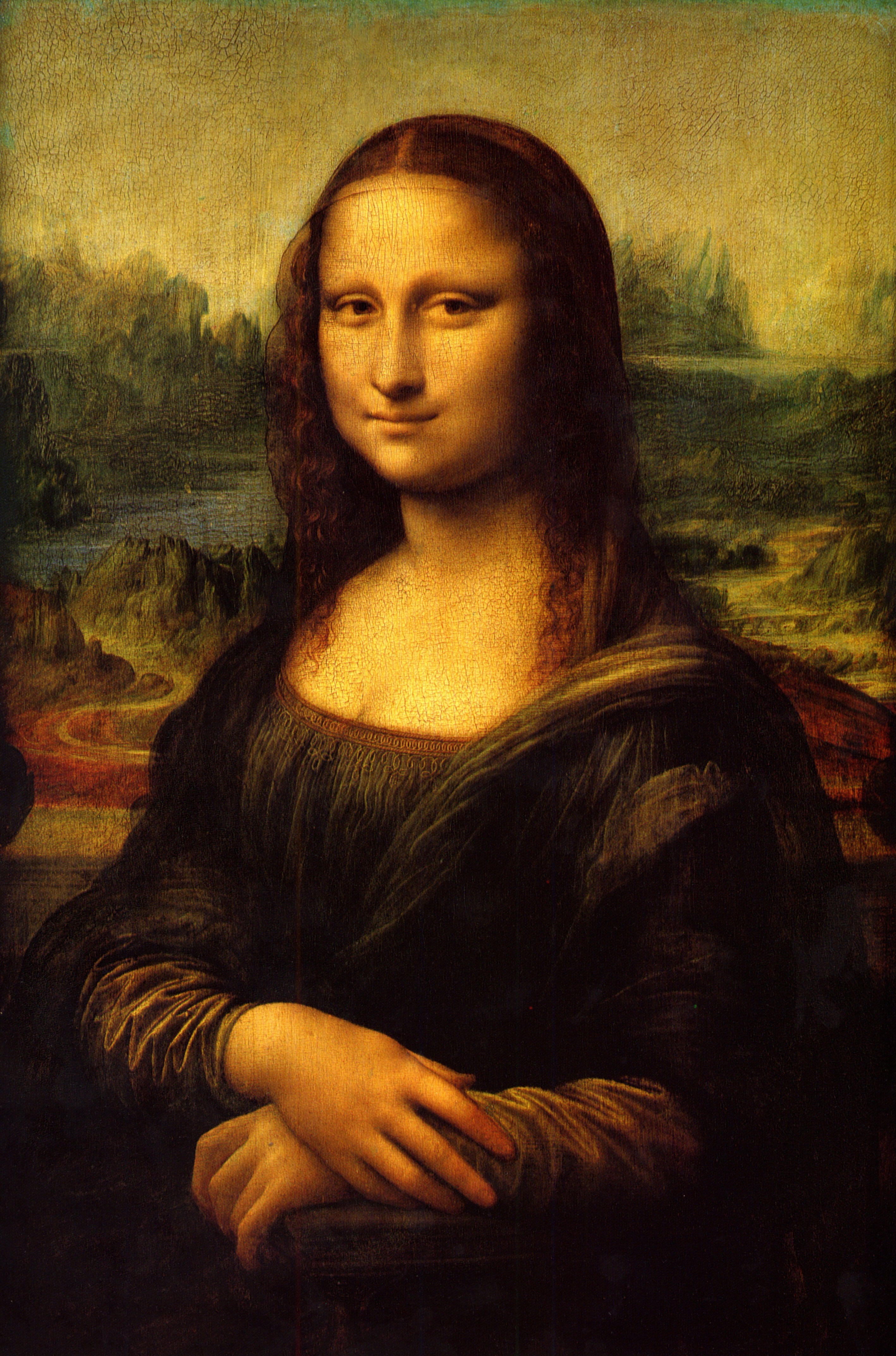
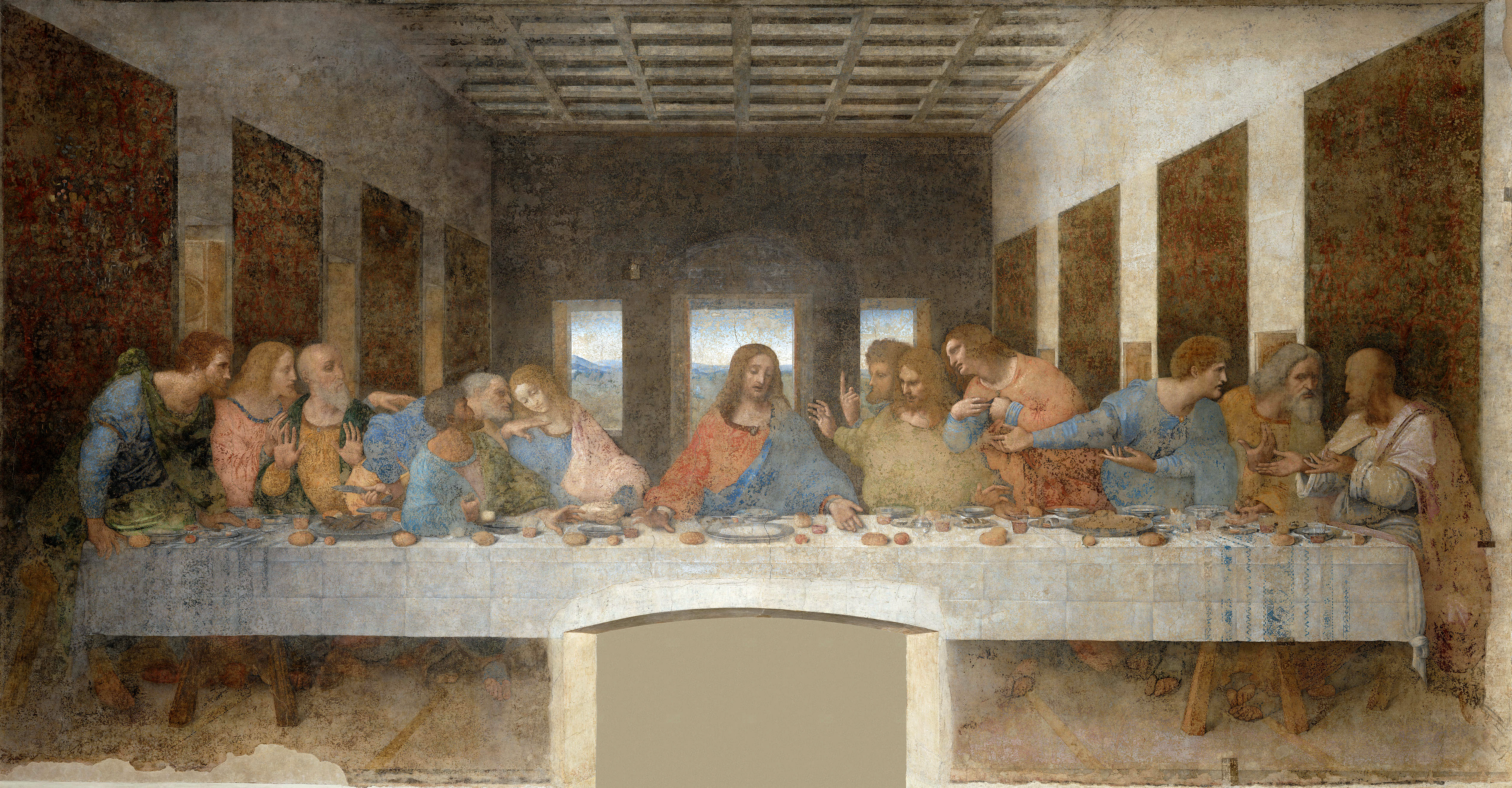
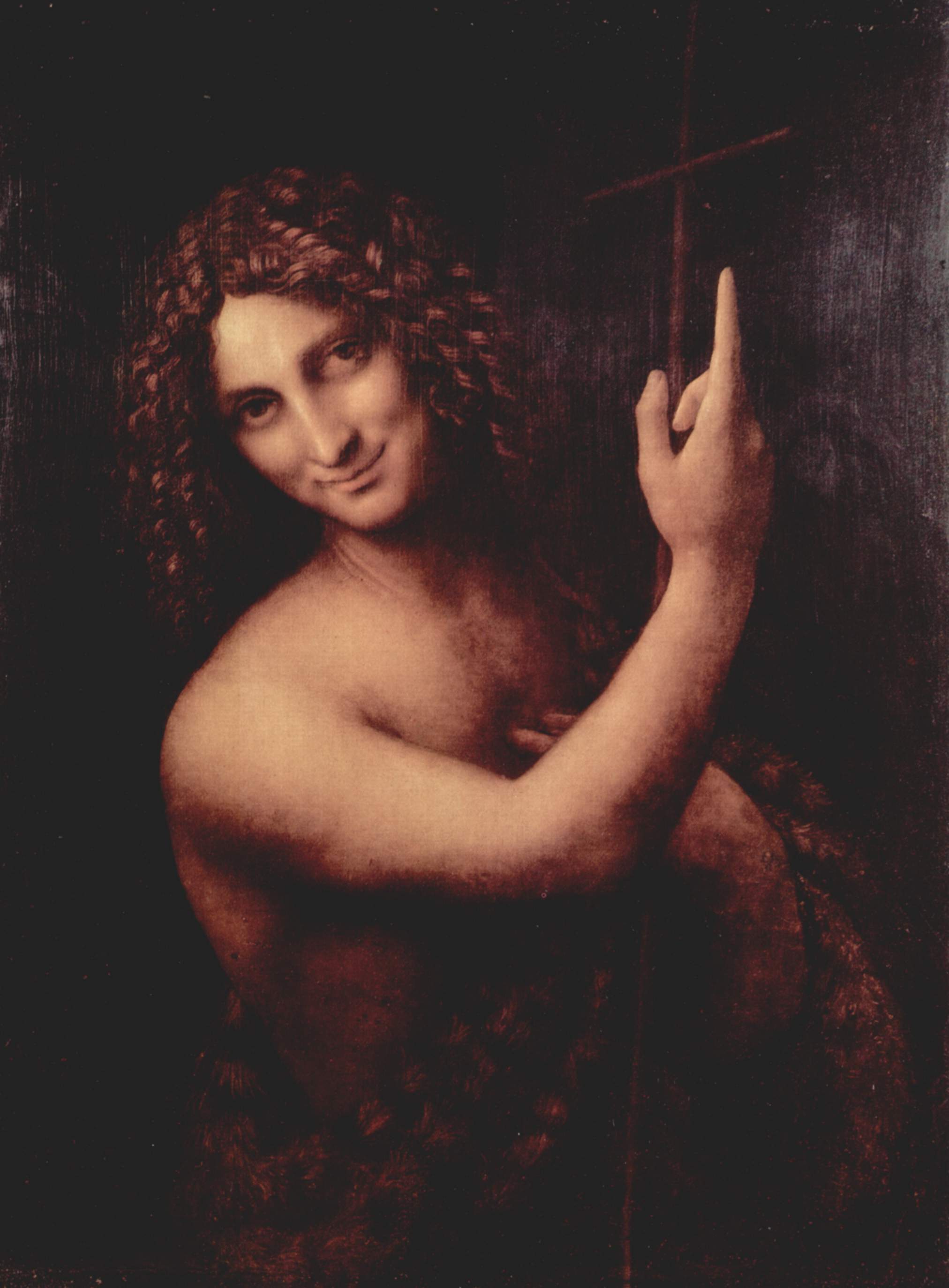
 Some famous paintings.
Some famous paintings.
 Woodcut
by Leonardo da Vinci for the Divina Proportione by Luca Pacioli 1509.
A rhombicuboctahedron,
an
Archimedean solid. F=26, E=48, V=24.
Woodcut
by Leonardo da Vinci for the Divina Proportione by Luca Pacioli 1509.
A rhombicuboctahedron,
an
Archimedean solid. F=26, E=48, V=24.
10. Johannes Widman
Biography in Dictionary of Scientific Biography
MACTUTOR.
Johannes Widman
Born: 1462 in Eger, Bohemia (now Cheb, Czech Republic)
Died: 1498 in Leipzig, Germany
Summary:
Johannes Widman was a German mathematician who is best remembered for an early
German arithmetic book (1489, reprinted until 1526)
which contains the first appearance of + and - signs.
This book was printed. It had more examples and a wider range
of examples than many others.
Graduated from University of Leipzig in 1482.
Later taught here. Taught the fundamentals of arithmetic and algebra.
First ever algebra lecture in Germany (1486).
Used Cossist notation as was usual at that time.
Considered computation with irrational numbers and polynomials to be part of algebra.
His book popular until those of Adam Ries and others appeared.
11. Ferro
Biography in Dictionary of Scientific Biography
MACTUTOR.
Scipione del Ferro
Born: 6 Feb 1465 in Bologna, Italy
Died: 5 Nov 1526 in Bologna, Italy
Summary:
Scipione del Ferro was an Italian mathematician who is famous for being the first to find a formula to solve a cubic equation.
WIKI.
Scipione del Ferro (February 6, 1465 – November 5, 1526)
Summary:
Italian mathemtatician who first discovered a means to solve cubic equations.









 Bigger image of statue
Bigger image of statue
 Santa Maria Novella, in Florence, Italy.
Bigger image.
Santa Maria Novella, in Florence, Italy.
Bigger image.
 Portrait from Vasari's Lives (1550)
Portrait from Vasari's Lives (1550)
 A sample of the art of Piero della Francesca (c. 1472)
A sample of the art of Piero della Francesca (c. 1472)
 A sample of the art of Piero della Francesca (1472)
A sample of the art of Piero della Francesca (1472)
 A sample of the art of Piero della Francesca (1472)
A sample of the art of Piero della Francesca (1472)





 The painting Ritratto di Frà Luca Pacioli (1495) now in Naples.
Painter unknown (perhaps Jacopo de' Barbari).
In the painting Pacioli is demonstrating a theorem by Euclid.
Table with
geomerical tools: slate, chalk, compass, a dodecahedron.
A rhombicuboctahedron half-filed with water is hanging to his right.
The painting Ritratto di Frà Luca Pacioli (1495) now in Naples.
Painter unknown (perhaps Jacopo de' Barbari).
In the painting Pacioli is demonstrating a theorem by Euclid.
Table with
geomerical tools: slate, chalk, compass, a dodecahedron.
A rhombicuboctahedron half-filed with water is hanging to his right.
 Woodcut
by Leonardo da Vinci for the Divina Proportione by Luca Pacioli 1509.
A rhombicuboctahedron,
an
Archimedean solid. F=26, E=48, V=24.
Woodcut
by Leonardo da Vinci for the Divina Proportione by Luca Pacioli 1509.
A rhombicuboctahedron,
an
Archimedean solid. F=26, E=48, V=24.
 Woodcut
from the Divina Proportione by Luca Pacioli 1509.
The divine proportion applied to the human face.
Woodcut
from the Divina Proportione by Luca Pacioli 1509.
The divine proportion applied to the human face.
 Statue outside the Uffizi, Florence
Statue outside the Uffizi, Florence

 The first of these is thought to be a self portrait.
The first of these is thought to be a self portrait.
 Leonardo da Vinci's Vitruvian Man.
Leonardo da Vinci's Vitruvian Man.



 Some famous paintings.
Some famous paintings.
 Woodcut
by Leonardo da Vinci for the Divina Proportione by Luca Pacioli 1509.
A rhombicuboctahedron,
an
Archimedean solid. F=26, E=48, V=24.
Woodcut
by Leonardo da Vinci for the Divina Proportione by Luca Pacioli 1509.
A rhombicuboctahedron,
an
Archimedean solid. F=26, E=48, V=24.